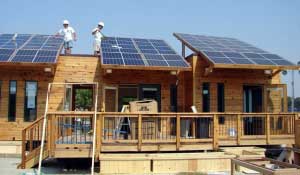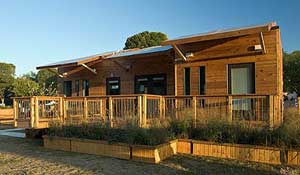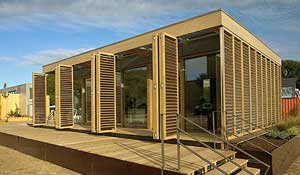|

Photo courtesy of Stephan Burdin/Martin Bettge
The 2007 Solar Decathlon included this entry from the University of Illinois, seen here in mid-construction. The building used photovoltaic solar panels on the roof.
|
|

Photo courtesy of Jim Tetro, Solar Decathlon, U.S. Department of Energy
The completed house from the University of Illinois looks very sleek and modern. It was built in modules, which enables variations in design. Renewable bamboo was used for much of the interior flooring and furniture.
|
|

Photo courtesy of Jim Tetro, Solar Decathlon, U.S. Department of Energy
The 2007 Solar Decathlon winner, from the Technical University of Darmstadt (Germany), used three modules for its main living areas, as well as materials local to Germany, such as oak, for its construction and flooring.
|
Every two years the U.S. Department of Energy holds the Solar Decathlon. In this international competition, which began in 2002, teams of university and college students compete to design and build the most attractive, effective, and energy-efficient solar-powered house. The sponsors of this competition, and other similar ones, want to stir the inventive juices of designers, architects, builders, and consumers, as well as educate everyone in what is possible.
In 2007, first prize went to Technical University of Darmstadt (Germany). Its entry combines high-tech active-solar and low-tech passive-solar components. The outer walls of the building consist entirely of louvered oak shutters covered with photovoltaic cells. The louvers adjust automatically to the angle of the Sun, thus generating electricity while simultaneously shading the house. The house also has a highly insulated flat roof covered with photovoltaic cells.
The runner-up in the 2007 decathlon was a building designed by a team from the University of Maryland (United States). It is called the LEAFHouse. LEAF stands forLeading Everyone to anAbundant Future, but the designers also found inspiration in the leaf “as nature's most efficient organism.” One of the home’s distinctive features is a green wall of vegetation. Another is an indoor waterfall that is used to control humidity. Solar panels that span the entire sloped roof provide all of the home’s energy and its hot water. It also has louvered shutters that adjust automatically, and the house has an overall adaptive-controls system that manages energy use against energy generation, making adjustments to minimize waste.
Technical University of Darmstadt repeated as the winner of the 2009 decathlon. The cube-shaped house was covered with photovoltaic solar panels on the exterior walls and roof. The house was built to produce twice as much electricity as it would need.




